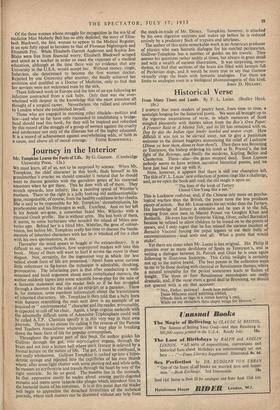Journey in the Interior
Mr. Tompkins Learns the Facts of Life. By G. Gamow. (Cambridge University Press. 12s.) WE must learn, all of us, not to be surprised by science. When Mr. Tompkins, the chief character in this book, finds himself in his grandmother's ovaries we should consider it natural that he should want to discuss genetics with the garrulous genes of his maternal ancestors when he got there. This he does with all of them. They stretch upwards, into infinity, like a receding spiral of Whistler's mothers. There to the right is a jolly looking old antihaemophilia- gene, recognisable, of course, from the healthy ruddiness in her cheeks. She is said to be responsible for Mr. Tompkins' thromboplastin, his prothrombin and his fibrinogen as well. Excellent. And on her left is his female sex-gene, a somewhat faded Mrs. Whistler with a classical Greek profile. She is without arms. She lost both of them, it seems, to some barbarians who invaded the island of Milos cen- turies ago. Behind her is a blind Mrs. Whistler, the gene of colour- vision, but before Mr. Tompkins really has time to discuss the funda- mentals of inherited characters with her he is whisked off for a chat with his own spermatozoa, in situ. Thereafter the mind ceases to boggle at the extraordinary. It is difficult to say, nevertheless, how unprepared readers will take this book. Many of them will want to hurl it across the room in sheer disgust. Not, certainly, for the ingenuous way in which the less talked about facts of life are presented. Apart from some curious little references to fig-leaves the technique is admirable, shocking, provocative. The infuriating part is that after conducting a well- reasoned and lucid argument about most complicated matters, the author suddenly lapses into some scientific horse-play for the sake of a fantastic statement and the reader feels as if he has struggled through a theorem for the sake of an epigram or a paradox. There is, for instance, some excellent information about the transmission of inherited characters. Mr. Tompkins is then told that a baby born with features resembling the man next door is an example of an acquired or " environmental " character and the reader, presumably, is expected to roll off his chair. Again, a large organic molecule with the admittedly difficult name of Adenosine-Triphosphate could well be called A.T.P. Chemists specify it in this very way in their own Journals. There is no excuse for calling it the reverse of the Parents and Teachers Associations whatever role it may play in breaking down the basic facts of life for popular consumption.
Throughout the greater part of this book the author guides his Gulliver through the gut, into reproductive organs, through the brain and out into a lecture hall where stark fantasy is relieved by a formal lecture on the nature of life. The gut, it must be confessed, is not really wholesome. Gulliver Tompkins is sucked up into a hypo- dermic syringe and injected into the capillaries of his own thumb where, after some light chatter with some passing red and white cells, he mounts an erythrocyte and travels through the heart by way of the right ventricle. So far so good. The trouble lies in the stomach. In that oppressive cavity he wades about among partly-digested remains and meets some tadpole-like phages which introduce him. to the bacterial fauna of his intestines. It is at this point that the reader will begin to appreciate the detached formalities of the technical Journals, where such matters can be discussed without any help from the stock-in-trade of Mr. Disney. Tompkins, however, is attacked by his own digestive enzymes and wakes up before he is reduced entirely by a predatory flock of trypsins and amylases.
The author of this quite remarkable work is an American professor of physics who uses Socratic dialogue for his morbid peripatetics. Gulliver-Tompkins has a number of guides on his travels. They answer his questions rather archly at times, but always in great detail and with a wealth of curious illustration. It was surprising, never- theless, to find that sections of the brain are filled with kennels full of Pavlovian dogs, and it would be more true to say that Gamow virtually clogs the brain with fantastic analogies. For there are limits to analogies even in a biological phantasmagoria of this kind.
JOHN D. HILLABY.


























 Previous page
Previous page